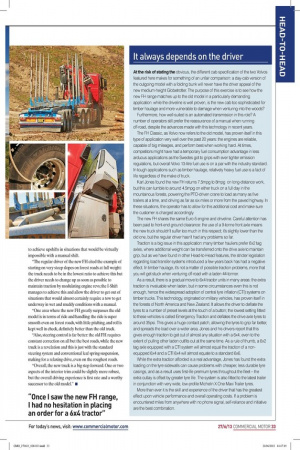It always depends on the driver At the risk of
Page 25

If you've noticed an error in this article please click here to report it so we can fix it.
stating the obvious, the different cab specification of the two Volvos featured here makes for something of an unfair comparison: a day-cab version of the outgoing model with a folding bunk will never have the driver appeal of the new medium-height Globetrotter. The purpose of this exercise is to see how the new FH range matches up to the old model in a particularly demanding application: while the driveline is well proven, is the new cab too sophisticated for timber haulage and more vulnerable to damage when venturing into the woods?
Furthermore, how well-suited is an automated transmission in this role? A number of operators still prefer the reassurance of a manual when running off-road, despite the advances made with this technology in recent years.
The FH Classic, as Volvo now refers to the old model, has proven itself in this type of application very well over the past 20 years: the engines are reliable, capable of big mileages, and perform best when working hard. At times, competitors might have had a temporary fuel consumption advantage in less arduous applications as the Swedes got to grips with ever tighter emission regulations, but overall Volvo 13-litre fuel use is on a par with the industry standard. In tough applications such as timber haulage, relatively heavy fuel use is a fact of life regardless of the make of truck.
Karl Jones found the new FH returns 7.5mpg to 8mpg on long-distance work, but this can tumble to around 4.5mpg on either truck on a full day in the mountainous forests, powering the PTO-driven crane to load as many as five trailers at a time, and driving as far as six miles or more from the paved highway. In these situations, the operator has to allow for this additional cost and make sure the customer is charged accordingly.
The new FH shares the same Euro-5 engine and driveline. Careful attention has been paid to front-end ground clearance: the use of a 9-tonne front axle means the new truck shouldn't suffer too much in this respect; it's slightly lower than the old one, but the regular driver hasn't had any problems so far.
Traction is a big issue in this application: many timber hauliers prefer 6x2 tag axles, where additional weight can be transferred onto the drive axle to maintain grip, but as we have found in other Head-to-Head features, the stricter legislation regarding load transfer systems introduced a few years back has had a negative effect. In timber haulage, it's not a matter of possible traction problems, more that you will get stuck when venturing off-road with a laden 44-tonner.
As a result, there is a gradual move to 6x4 tractor units in many areas: the extra traction is invaluable when laden, but in some circumstances even this is not enough, hence the widespread adoption of central tyre inflation (CTI) systems on timber trucks. This technology, originated on military vehicles, has proven itself in the forests of North America and New Zealand. It allows the driver to deflate the tyres to a number of preset levels at the touch of a button; the lowest setting fitted to these vehicles is called Emergency Traction and deflates the drive axle tyres to around 35psi. This gives a huge contact patch, allowing the tyres to grip far better, and spreads the load over a wider area. Jones and his drivers report that this gives enough traction to get out of almost any situation with a 6x4, even to the extent of pulling other laden outfits out at the same time. As a rule of thumb, a 6x2 tag axle equipped with a CTI system will almost equal the traction of a nonequipped 6x4 and a CTI 6x4 will almost equate to a standard 6x6.
While the extra traction afforded is a real advantage, Jones has found the extra loading on the tyre sidewalls can cause problems with cheaper, less durable tyre casings, and as a result uses first-life premium tyres throughout the fleet — the extra outlay is offset by greater tyre life. The system is also fitted to the latest trailer in conjunction with very wide, low-profile Michelin X One Maxi Trailer tyres.
More than ever it is the skill and experience of the driver that has the greatest effect upon vehicle performance and overall operating costs. If a problem is encountered miles from anywhere with no phone signal, self-reliance and initiative are the best combination.








































